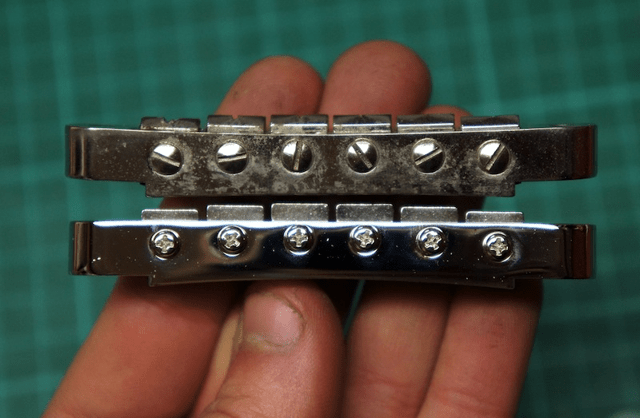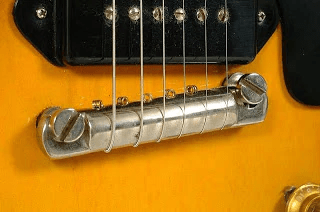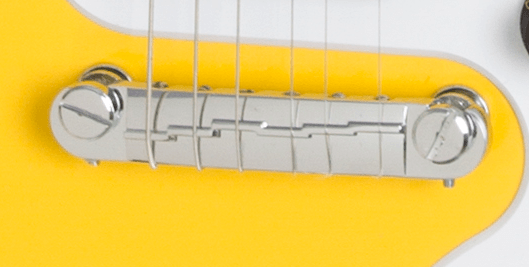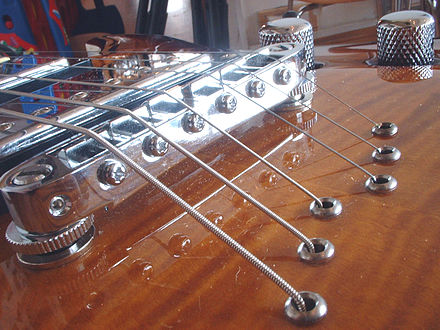Tune-O-Matic
 A Tune-O-Matic bridge.
A Tune-O-Matic bridge.
The venerable Tune-O-Matic, a typical sight on Gibson models since the early 50s, now also seen on some Fender models (under the name Adjusto-matic) and countless other brands’ guitars. It has its pros and cons, but overall is a pretty great design.
It’s a two-part construction, with a separate bridge and tailpiece; the tailpiece is held in place by the tension of the strings — I recommend taping it down when restringing or doing maintenance to keep it from falling onto the body and damaging the finish.
The bridge itself sits on two posts and has a set of six saddles, individually adjustable for intonation from the front with (usually) a flat-head screw. This has certain problems; on guitars with particularly tall bridge pickups it’s almost impossible to adjust intonation without taking the bridge off, and action adjustments are very crude, since you only have two points to adjust the action at. Adjusting the action is done with very finely knurled thumb-wheels rather than, e.g., screws, and doing it under string tension ranges from “borderline impossible” to “very difficult but risking permanent damage to the guitar”. Loosen all the strings before fiddling with your TOM’s height!
Some versions of a Tune-O-Matic can be easily modded to allow for adjustment from the back by just taking out the screws and saddles and reinserting them from the other side, or reversing the saddles and then flipping the entire bridge, but then the tailpiece gets in the way of adjustment.
The range of intonation adjustment is also pretty narrow, and it’s not uncommon to see one or more saddles on a Tune-O-Matic maxed out in their travel in an attempt to get the instrument to intonate correctly.
Bridge collapse
The Tune-O-Matic bridge has one inherent design flaw. Because it’s only supported at the ends, while the strings exert pressure over its entire width, a lot of cheaper TOM-style bridges will collapse over time.
 A collapsed (top)
Tune-O-Matic bridge compared to a “healthy” (bottom) one.
A collapsed (top)
Tune-O-Matic bridge compared to a “healthy” (bottom) one.
The saddles of a Tune-O-Matic are not individually adjustable for height, and so when the bridge collapses — i.e. when its middle section sags under string pressure — the middle strings end up having much less clearance over the fretboard compared to the outer ones.
If your Tune-O-Matic-equipped guitar develops a buzz on the D and G strings or seems to require higher action than it used to, that’s usually a warning sign that you’ve got a collapsing bridge.
I’m aware of one solution that actually fixes the problem by having the entire bridge be in contact with the body — the Babicz version of the Tune-O-Matic — but it’s expensive and quite distinct from a standard TOM visually. You can, however, highly reduce the chance of a bridge collapse without resorting to such drastic measures.
A bridge made with higher-quality materials (e.g. brass, aluminium) will not collapse as readily as one made with cheaper metals, so getting high-quality parts is particularly important with a Tune-O-Matic.
The primary course of action to help avoid a bridge collapse, however, is setting your tailpiece height properly.
A tailpiece set too low leads to a very sharp string break angle over the bridge and so lots of downwards force that can hasten a bridge collapse. Setting the tailpiece height on a Tune-O-Matic is a balancing act between too much downwards force — risking a bridge collapse — and too little, which can cause buzz and problems with tuning stability and string retention.
A good rule-of-thumb I’ve found for setting the height on a Tune-O-Matic tailpiece is to start by lining up the top surface of the tailpiece with the highest saddles on the bridge and adjust from there.
Upgrade Options
Certain manufacturers (Gotoh, Hipshot) make aftermarket TOM-style bridges that can additionally slide back and forward on the support posts and can be locked down with a screw in an attempt to extend the available range of intonation adjustment. If you find that you don’t have enough saddle travel to get your guitar to intonate properly, they might be something worth looking into.
I’d like to also mention the Babicz FCH version of the Tune-O-Matic, as that’s — as far as I’m aware — the only design which attempts to fix all the issues inherent to the standard TOM design.
It’s extremely pricy, annoying to adjust (because it has so many screws and adjustment points), and, in my personal opinion, ugly as hell, but it does have individually-adjustable string action, the intonation is adjusted by a prominent hex screw — which lets you do it from an angle with an allen key rather than trying to awkwardly fit a screwdriver in — and it has a much larger range of motion than standard TOM saddles (and if that’s not enough, you can push the entire bridge back or angle it slightly by adjusting the screws that bind against the posts). Not only that, but the “full contact” design means it’s unlikely this bridge will ever collapse.
On the other end of the spectrum, Schaller make Tune-O-Matic clones with roller saddles (for use with vibrato tailpieces) that are adjustable for string spacing.
To my surprise, compared to Fender-style bridges, there just aren’t that many variations on the Tune-O-Matic formula. I suppose it’s not that weird — it’s a pretty good design and there aren’t that many low-hanging fruit issues with it which can be easily fixed without a fundamental redesign.
My suggestion? If you have a Tune-O-Matic bridge on your guitar, it’s probably good, and there’s not much reason to upgrade it. If you do decide to swap it out, make sure to double- and triple-check the specs. There are lots of minor variations on the mounting with slightly (and I mean fractions of a millimeter, but enough to make them incompatible with each other) different string spacing, post spacing, post and thumb-wheel diameter… Measure every part of your bridge, and then see if your desired replacement bridge will fit. Worst case, you might need to rip out the old bushings and press in new ones.
Related designs
We’ve talked about the standard Tune-O-Matic, but there’s a lot of variations on the classic formula.
I talk a lot about Fender cutting every possible corner, but Gibson is not immune to sacrificing quality in the name of saving a couple cents either.
When trying to figure out the answer to “what is the cheapest, worst guitar we can possibly make?” Gibson looked even to the venerable Tune-O-Matic in search of cost savings. After, no doubt, a night of smoking two thirds of the periodic table, someone suggested the brilliant idea of just removing the bridge altogether.
“What if we just feed the strings into the tailpiece from the front, wrap them around and call it a day?”
I would like to present to you, the worst excuse for a bridge ever conceived by a commercial guitar manufacturer; the vintage wraparound bridge:
 A vintage wraparound
bridge.
A vintage wraparound
bridge.
Yup. That’s just a tailpiece. There’s no adjustment for intonation, there’s only symbolic adjustment for action, the strings don’t really have anything preventing them from moving side-to-side. Restringing these is also an adventure, because you need string tension pulling them towards the neck to keep them from crashing onto the body, but you have to pull strings through them away from the neck… It’s fun™️.
Some years later Gibson realized that this disaster is beneath even them, and added… some raised pieces to work as saddles.
 A “modern”, compensated
wraparound bridge.
A “modern”, compensated
wraparound bridge.
High-fives were had all around, no doubt, and this variant survives to this day on low-end models like the Melody Maker. There’s still no adjustability, but at least there’s some compensation to make it vaguely intonate.
Fortunately, plenty of other companies have stepped up and offer wraparound designs that actually work as a bridge. Gotoh and Schaller come to mind immediately, both offering wraparound bridges that are easier to restring, with saddles individually adjustable for intonation.
Of course, since Gibson removed the bridge itself from some of their guitars, they also removed the tailpiece from others. Turns out, you can avoid having to use a tailpiece if you just thread the strings through the body:
 A Tune-O-Matic bridge
with through-body stringing.
A Tune-O-Matic bridge
with through-body stringing.
Alternately, you can then combine your Tune-O-Matic bridge with a vibrato tailpiece, like a Bigsby or a Jazzmaster trem. Jazzmaster bridges suck so badly that it is pretty common for both Fender/Squier and offbrand copies of Jazzmasters to just use a Tune-O-Matic bridge with a Jazzmaster tailpiece.